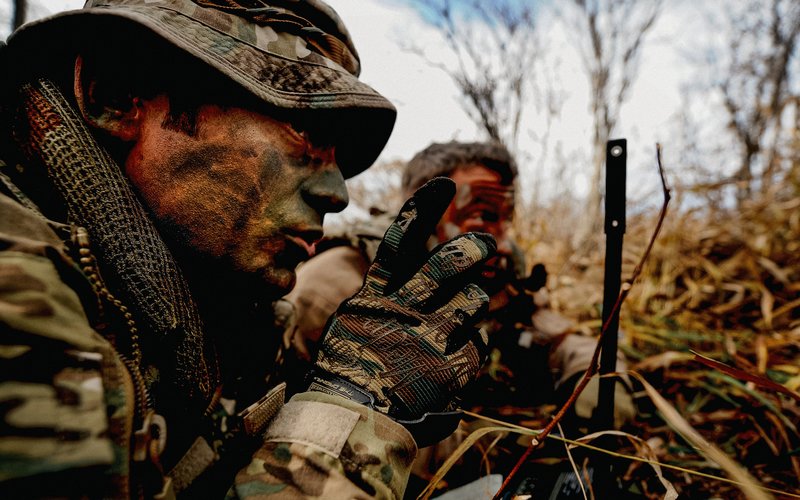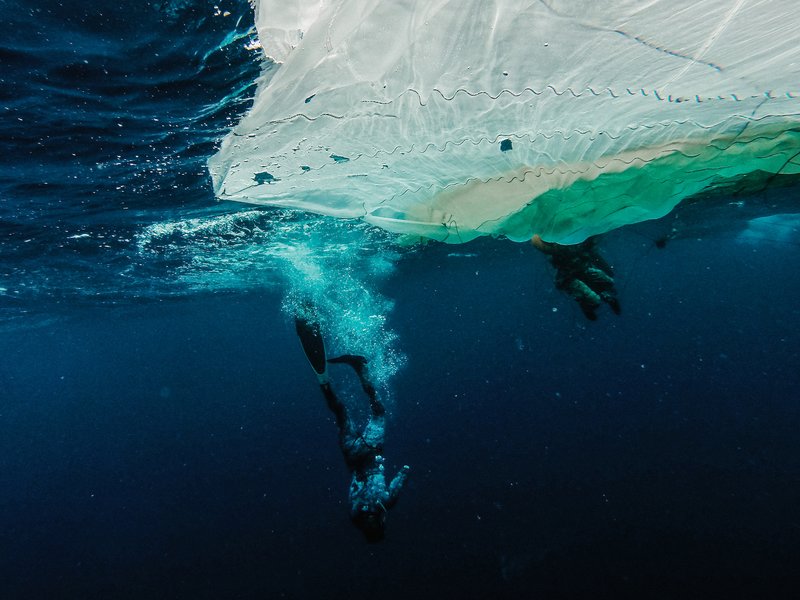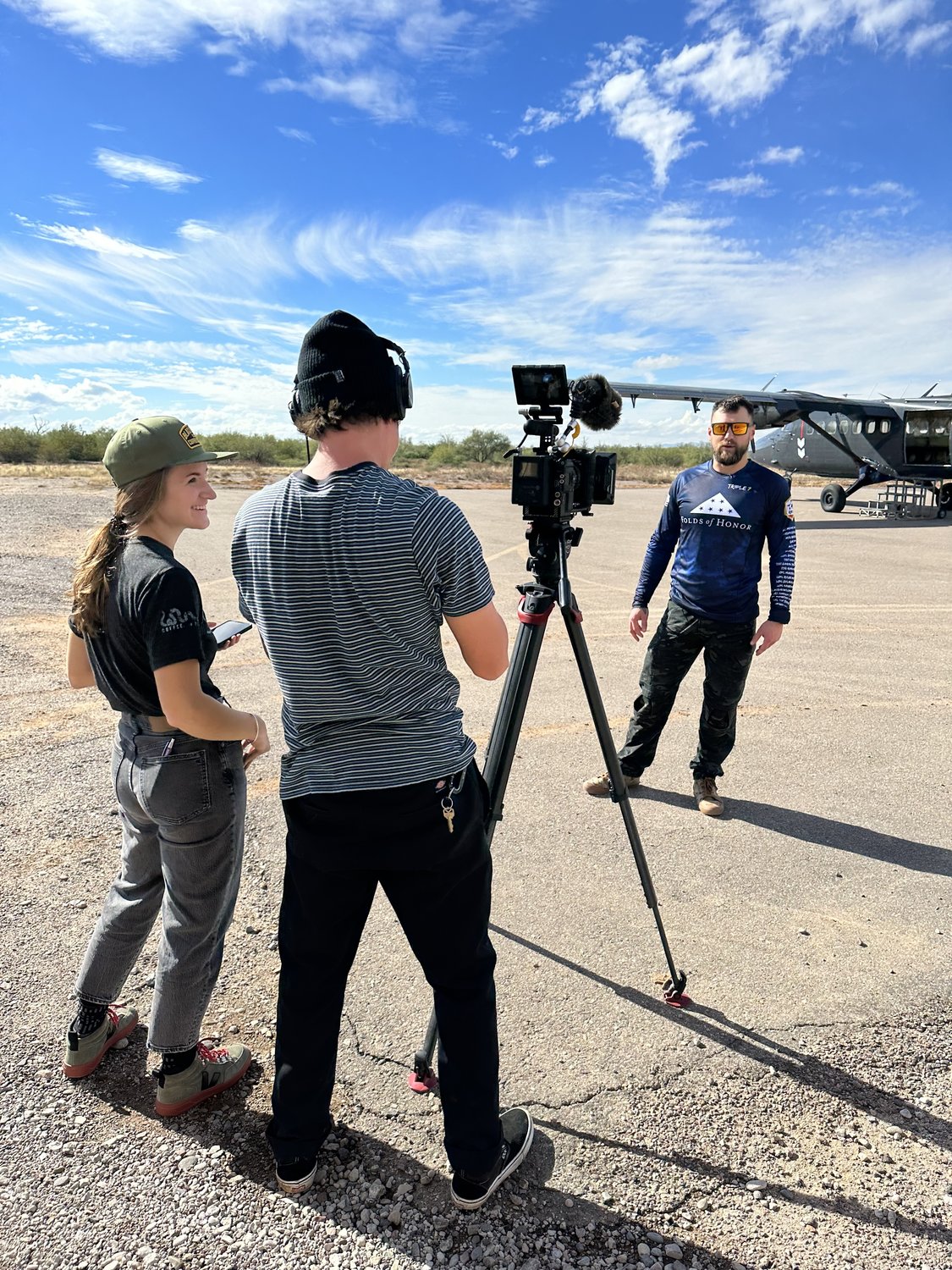SERE School: The Infamous Course That Teaches US Troops to Survive ‘With Honor’

An airman applies camouflage to his face during S-V-80-A, a 19-day course at Survival, Evasion, Resistance, and Escape, or SERE, school at Fairchild Air Force Base, Washington, on Feb. 25, 2020. US Air Force photo by Staff Sgt. Corban Lundborg, using a Holga 120N plastic camera with 120mm medium format film.
In 1965, the North Vietnamese Army captured four American pilots and detained them in a single cell at the Hoa Lo Prison in Hanoi. The Americans — Capt. Carlyle Harris, Lt. Phillip Butler, Lt. Robert Peel, and Lt. Cmdr. Robert Shumaker — knew they’d soon be split up, so they spent the next few days devising a tap code that would allow them to communicate with each other through walls.
The code, based on one Harris had learned from an Air Force instructor, was premised on an imagined five-by-five alphabet matrix, with the letter “A” in the top left corner and “Z” in the bottom right. The “speaker” would tap a letter’s row number, pause, then its column number. For example, “A” is one tap, pause, one tap; “B” is one tap, pause, two taps; and so on. The code omitted the letter “K” to keep the grid an even five-by-five square. Where a “K” was needed, “C” was used instead.
After Harris, Butler, Peel, and Shumaker were separated into different cells, they began teaching other POWs the tap code. Before long, most of the inmates had it memorized and were transmitting intel throughout the camp unbeknownst to their guards. As POWs were transferred out of Hanoi, the use of tap code spread, and because of it, so did useful information, so that in time a vast underground communications network was established, allowing inmates at different camps to not only coordinate resistance efforts, but also build a sense of camaraderie among them that strengthened their resolve to resist the demands of their captors.

US Air Force SERE specialist Tech. Sgt. Bobby Colliton instructs Staff Sgt. Dane Hatley while performing combat survival training during Exercise Pacific Thunder 2012 near Osan Air Base, South Korea, on Oct. 15, 2012. US Air Force photo by Staff Sgt. Sara Keller.
Inevitably, in every war, soldiers will be taken prisoner, and some of those who are will be killed, interrogated, or tortured. It is a reality that all armies must prepare for. The US military does so by requiring certain troops — namely, those most likely to end up isolated in hostile territory — to undergo a brutal training program called Survival, Evasion, Resistance, and Escape, or SERE, school. SERE school teaches them, among other things, how to survive off the land while evading enemy forces. If captured, they’re instructed to resist their captors — as the four pilots did at Hanoi — and to do so without betraying their country so they can ultimately return home “with honor.”
Related: This Mexican American POW Survived 8.5 Years Inside the ‘Hanoi Hilton’
SERE Gets Its Start
The origins of SERE school trace back to World War II, when MI9, a super-secret intelligence department of Britain’s War Office, helped POWs escape from Nazi camps. After the Americans joined the war in 1941, MI9 shared its escape and evasion methods with the US Army Air Forces, which used them as the blueprint for survival training programs, which would gradually form at various military garrisons around the country.
Initially, the program was primarily focused on teaching troops how to make it back to friendly lines in the event they ever found themselves stranded in enemy territory. It wasn’t until the Korean War that the Department of Defense realized that the training lacked one crucial component: preparing service members to resist their captors.
Between 1950 and 1953, more than 7,000 Americans were taken prisoners of war on the Korean Peninsula. More than 2,700 of them — nearly 40% of the total number captured — never made it out of the camps alive. Many of those who survived captivity did so despite having been subjected to torture and starvation. Perhaps some survived because they ultimately complied with their captors and participated in North Korean propaganda.

US Air Force SERE student Staff Sgt. Thomas Thorpe builds a fire at a training site in the Colville National Forest in northeastern Washington on Oct. 8, 2021. US Air Force photo by Airman Jenna A. Bond.
The staggeringly low survival rate among American POWs in Korea was a wake-up call for the brass. So were the thousands of petitions from POWs urging Washington to end the war, and the signed confessions of their alleged crimes, and the fact that 21 of them defected to the other side. All of this made clear that more needed to be done to prepare troops not just to survive behind enemy lines, but also to uphold their constitutional oath under extreme duress.
Thus, on Aug. 17, 1955, President Dwight D. Eisenhower issued Executive Order 10631, which outlines the “Code of Conduct for Members of the Armed Forces of the United States.” A foundational document for the SERE courses taught today, it is essentially a rule book for service members to follow if taken prisoner of war.
Related: EOD: A History of Explosive Ordnance Disposal From World War II to Today
Air Force SERE School
The Air Force’s SERE curriculum underwent several iterations before it was more or less finalized in 1961. Initially, the training was held at Stead Air Force Base in Reno, Nevada. After the base closed in 1966, the schoolhouse was moved to Fairchild Air Force Base in Washington State, and has remained there ever since.

US Air Force SERE specialist Tech. Sgt. Bon Strout dives below a floating parachute during water survival training off the coast of Okinawa, Japan, on Nov. 4, 2015. US Air Force photo by Senior Airman Scott Fremming.
Approximately 20,000 service members attend Air Force SERE school programs every year. There are a total of 19 different courses within the program, each with a unique curriculum tailored to a certain environment or set of circumstances. For example, there is a course that teaches troops how to apply their SERE skills and knowledge in the jungle. Another, in the arctic. Another, at sea. But among most airmen, the term “SERE school” describes just one specific course: S-V-80-A, or Basic Combat Survival.
S-V-80-A is the Air Force SERE school’s 19-day flagship course. Held 49 weeks out of the year, it is the standard level C, or highest tier, “Code of Conduct” training for aircrews, special operators, and other service members at higher-than-normal risk of being stranded behind enemy lines. (Level A is taught at basic training, and Level B courses are for personnel at moderate risk of capture, such as infantry soldiers deployed overseas.) S-V-80-A unfolds in three stages of training: classroom, field, and captivity. Land navigation, shelter construction, food procurement and preparation, evading enemy forces, and resisting interrogation are all on the training docket. Many of the skills and techniques taught in the course are classified. It is said, though impossible to confirm officially, that SERE is the only school in the US military where the instructors are allowed to strike their pupils.
Although the Air Force was long the executive agency for evasion and escape training, the Army, Navy, and Marine Corps all now have their own SERE schoolhouses. Today, all Army Special Forces candidates must attend a C-level SERE school at Camp Mackall, North Carolina, before they earn their green beret. Also in North Carolina, the Marine Corps conducts C-level training at Camp Lejeune. And the Navy conducts much of its higher-level SERE training in California and New England.
However, only the Air Force has a career field dedicated to gathering and teaching survival skills. In an almost-six-month-long apprentice course, Air Force SERE specialists become subject matter experts in forest, desert, coastal, tropic, and open-ocean survival. Only then can the newly minted instructors teach others how to survive in those same unforgiving environments — and with honor.
Read Next: ‘That Others May Live’: What It Takes To Be an Air Force Pararescueman

Jenna Biter is a staff writer at Coffee or Die Magazine. She has a master’s degree in national security and is a Russian language student. When she’s not writing, Jenna can be found reading classics, running, or learning new things, like the constellations in the night sky. Her husband is on active duty in the US military. Know a good story about national security or the military? Email Jenna.
BRCC and Bad Moon Print Press team up for an exclusive, limited-edition T-shirt design!
BRCC partners with Team Room Design for an exclusive T-shirt release!
Thirty Seconds Out has partnered with BRCC for an exclusive shirt design invoking the God of Winter.
Lucas O'Hara of Grizzly Forge has teamed up with BRCC for a badass, exclusive Shirt Club T-shirt design featuring his most popular knife and tiomahawk.
Coffee or Die sits down with one of the graphic designers behind Black Rifle Coffee's signature look and vibe.
Biden will award the Medal of Honor to a Vietnam War Army helicopter pilot who risked his life to save a reconnaissance team from almost certain death.
Ever wonder how much Jack Mandaville would f*ck sh*t up if he went back in time? The American Revolution didn't even see him coming.
A nearly 200-year-old West Point time capsule that at first appeared to yield little more than dust contains hidden treasure, the US Military Academy said.












